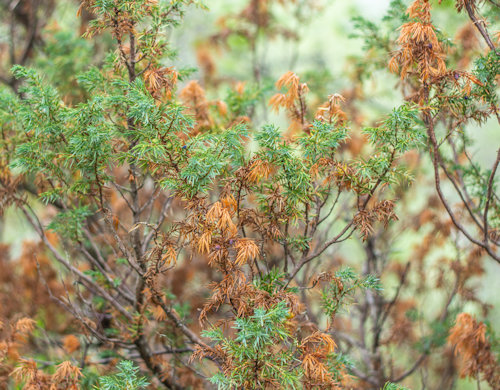What Is the Threat
Diplodia Tip Blight is a type of fungal disease, officially known as Diplodia pinea, syn. Sphaeropsis sapinea. This disease primarily affects pine trees, specifically Austrian, Ponderosa, Mugo, and Scots Pine species. The fungus typically develops on the tree’s needle fascicles and then spreads outward to the entire branch.
On the surface of the branch, you may notice dark-looking cankers. Internally, the fungus infects the branch’s vascular tissue with a special type of blue stain. Both actions can kill the branch and eventually lead to total tree loss.
Trees that have been damaged or weakened by adverse weather such as wind, hail, or ice, are especially susceptible to Diplodia Tip Blight. In addition, elevated moisture levels can also make a pine tree more vulnerable to this condition.
Where Is the Threat
Any type of pine tree can fall victim to this disease, though the aforementioned species are most vulnerable. Of the four, Scots Pines and Mungo Pines are the least likely to experience Diplodia Tip Blight.
While pine trees are plentiful in southern Maryland, they’re also present all around the Northeast, as well as the Midwest. In fact, you can find these species all around the United States. It’s important to note that this condition is most common in established landscape trees that are at least 30 years old.
Symptoms of Diplodia Tip Blight
If your pine tree is infected with Diplodia Tip Blight, then the first symptom you may notice is a gradual browning of the tree’s needle bundles. Though this discoloration can start at the tip of the affected needles, it can quickly spread inward and invade the entire branch.
When this occurs, dark and knotty cankers will appear on the branch. In time, the branch will die. If left untreated, total tree loss can occur in species infected with Diplodia Tip Blight.
What to Do About the Problem
If you suspect that your pine tree has been infected with Diplodia Tip Blight, then it’s important to seek professional treatment as soon as possible. Our team can identify the symptoms of this disease and recommend appropriate next steps. We help homeowners in and around Charles, St. Mary’s, Anne Arundel, and Calvert County keep their plants and trees in great shape.
For this condition, we will recommend a targeted tree injection treatment that can heal your tree from the inside out. Ideally, this treatment should be performed in the late fall. During that time, the pine tree’s resin flow will be reduced, which can aid in optimal uptake of the solution.
Note that the timing of your treatment is critical. A tree in the early infection stage will still look mostly green, with minimal tip browning. Treatment is still recommended at that time, though a tree in the late infection stage (more than 50% brown) may be too damaged to treat.
Early, preventative treatment is best. By protecting your pine tree prior to infection, you can ensure that its needle bundles will remain healthy and green.
NEED HELP?
If you live in Southern Maryland, or Northern Virginia
FIND YOUR SOLUTION HERE
People, Pet & Pollinator Safe! Pest control for people who care.
